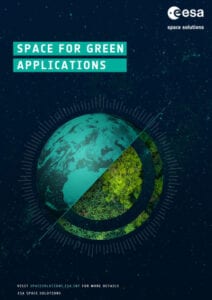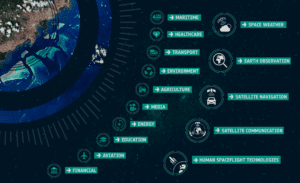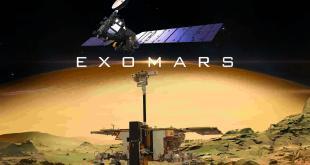 When we think about our environment, we do not tend to include space. However, with increasing alerts of possible space pollution and a rising urgency to deal with space debris, the question of a “Green Space” has become pertinent. How can space and in-orbit technologies become sustainable and environmentally friendly? What do space assets and services contribute to an efficient and future-proof eco-management of the Earth?
When we think about our environment, we do not tend to include space. However, with increasing alerts of possible space pollution and a rising urgency to deal with space debris, the question of a “Green Space” has become pertinent. How can space and in-orbit technologies become sustainable and environmentally friendly? What do space assets and services contribute to an efficient and future-proof eco-management of the Earth?
We obviously have two different questions in front of us. One: how green can space technology get? And the other: how can our space engagements help us to improve the use of our resources on Earth, become energy-efficient and sustainable and better manage the climate change?
The European Space Agency (ESA) engages in both. Through its wide array of development and business programs, the agency sets our course in both, making space assets more friendly to the environment in which they operate and applying them to improve carbon neutrality and energy efficiency on Earth.
Let’s start with the first: green technologies in space. Spanning from manufacturing on Earth to operations in orbit, ESA supports numerous programs to reduce the use of harmful substances in the production of launchers and spacecraft and invests in the development of safe constellations and environmental-friendly propulsion systems. ESA recently tested, for instance, the development and use of a “green” satellite thruster, the “Green Liquid Apogee Engine”, as an alternative to today’s hydrazine-based engines. The tests were held in Poland.
The cooperation of ESA and eight countries with ClearSpace, a start-up in Switzerland, is another example. ClearSpace leads an industrial team that develops the world’s first active debris removal mission, ClearSpace-1. It’s a new way of doing business and forging productive public-private partnerships.

The next step towards sustainability is to take this beyond the mere industrial production and in-orbit operations of satellites. It’s not only about the environmental footprint of the manufacturing and the hardware but about the profile of the products and services that these assets deliver on Earth. It will be like double leveraging one day, when green space technologies translate into green applications on Earth. The story has to be told: space technologies are a significant contributor to a sustainable life on Earth and a responsible use of our resources on this planet.
ESA Space Solutions, a transversal task force within ESA working on the application and implementation of space systems and constellations in Earth-bound solutions, has framed this task in a wide range of programs and projects that it incubates, catalyzes, ferments, funds, and exercises.
It assembled data from 90 ESA studies and demonstrations that were conducted over a decade and summarized them for more than a dozen areas of green space applications. From maritime to agriculture, from navigation, aviation, and transport to energy, education and construction – ESA Space Solutions forged green alliances across entire ecosystems to foster cooperation, incite research and encourage the development of green space-based and hybrid business models and services.

GridEyeS, a service to monitor and maintain electric utilities based on Artificial Intelligence; MineSense, a community of over 200 members active in sustainable mining and water supply control worldwide; DryGro, a satellite-enabled technology to produce sustainable, not-soy animal food; TeleRetail, an on-demand service to use robots for autonomous goods delivery; TransparentSea, a service to address illegal fishing; and ThermCERT, a tool to improve the thermal efficiency of houses: ESA empowers and supports engineers, governments, institutions and entrepreneurs to solve some of the most urgent questions when it comes to “Green Space” on Earth.
It suggests solutions to monitor our power generation and energy supply, optimize the often unpredictable and volatile output of natural resources, and survey power lines and grids that are often difficult to inspect with helicopters and drones only. In hydroelectric, wind, solar or energy microgrids – satellite images are key to improve the situational awareness and our capabilities to efficiently align energy demand and supply. They help survey the logistics and assess the resources and environmental profile of marine energy installations. In digital mining, they enable companies to monitor sites and their natural surroundings. They allow us to trace goods, track illegal activities and monitor waste management.
ESA’s space assets and ESA Space Solutions help to push for circular economy models, for a better use and recycling of our resources on Earth. ESA recently launched a funding call for circular economy models. Teams, talents, start-us and entrepreneurs of the possibly widest scope are invited to submit their ideas how to optimize chains in food and drinks, fashion and textiles, urban life and innovative waste management.
Space supports the construction of energy efficient buildings. Earth Observation facilities help to decide where to build, identify risk and safe zones, optimize energy consumption, and allow for green renovations. Space-based digital dashboards and twins can help the real estate sector to reach science-based sustainability targets. ESA Space Solutions recently launched an initiative to develop Green Urban Areas.
ESA has partnered with ENEL, an international utility and power company, to transition public transport systems towards zero carbon emission solutions. Smart mobility, on the ground and in the air, clever navigation, effective routing and the use of robots for delivery, 5G-based traffic and congestion management, smart vehicle communication, as well as cargo tracking and tracing to install digital services for transport and logistics – ESA is putting a wide array of elements and building blocks of a 21st century urban and rural life management in place
Precision agriculture, yield prediction, land restoration and pest detection, the tracing, tracking, and trading of sustainable food, the surveillance of wildlife, habitats and biodiversity, air and water usage, weather and the status of pollution: the list of possible applications of space technologies on Earth, that can be leveraged and overlaid for a better understanding and a beneficial management of life on our planet, is virtually infinite.
“Green Space”: satellite applications are crucial for the development of green services on Earth. Seamlessly integrated with terrestrial technologies, they can help to address the most urgent challenges of managing our planet and achieve the green transformation. ESA Space Solutions is driving the evolution.






